It’s September 2024, and to mark the beginning of a ‘career sabbatical’ I am departing London, England, for Kathmandu, Nepal. I’m severing all the habits, rituals, and conventions of my daily life – both the ones I want to be rid of, as well as those I have grown attached to. I’ve found I can clear my mind and create space for contemplation by hiking. So, where better to go than Nepal — arguably the best place in the world to do so.
Experiencing the Himalaya is a pilgrimage for monks, worshippers, trekkers and thrill-seekers alike.
For Buddhists, Hindus, and all who rely on its resources, the mountains are sacred. Hundreds of thousands migrate each year from all over southern and central Asia to witness its 1,500 distinct peaks rippling across 230,000 square miles. Some seek enlightenment, others accomplishment, whilst a few wander in search of answers.
I am one of those wanderers. My journey takes me from Besisahar with four guides, six porters and eleven other trekkers. The path weaves up the Marshyangdi Valley in the east and down the Kali Gandaki Valley to the west on the Annapurna circuit. By its conclusion, we will cover 120km on foot with close to 10,000 metres (32,800 feet) of altitude gain. It’s a challenge that promises to reshape me in ways I can’t yet predict.
My purpose, beyond reaching the highest point at Thorong La Pass (5,416 metres above sea level), is to create space. To detach from the rhythms of a lifestyle which has stagnated. For six years, I’ve lived and worked in a place that never quite felt like home. Now, I am stepping back to see what emerges when I distance myself from everything I’ve built. Deep down, I seek a sense of direction—something I’m not the first to search for in the “Home of Snow”.
12th September
Upon arriving in Kathmandu, the air is thick with the fumes of lorries, cars and motorbikes. Combined with stifling heat and a metallic tang, it’s an assault on the senses. I’ve come to Nepal for lungfuls of mountain air, yet my throat scratches upon leaving the arrivals hall. I’ve preorganised a driver to rescue me from the throng of touts and taxis. He’s unfamiliar with the sounds coming out of my lips, but that doesn’t seem to prevent him from nodding along as I prod at my homestay’s location on a map. With a half-smile on his rosy cheeks, he crunches his Tata into gear, and we’re on our way.
The putrid sulphur scratching my nostrils suggests catalytic converters are yet to arrive in this part of the world. We weave through gaps in traffic; I’m still unsure which side of the road is legal. Common sense and nimble reactions are compulsory to drive through alleyways where only inches separate your wing mirror from the wall.
It’s a 20-minute journey as the crow flies, and now one hour in, I’m unconvinced my driver knows the way despite his cheeky grin. Any hope dissipates as we draw up to a pharmacy. The driver winds down his window and shouts something in Nepali to the shopkeeper, who snaps back a few words and wags a finger. Addresses have little value in these parts, as drivers navigate by memory or by the guidance of locals.
After three minor scrapes and fourteen wrong turns in the space of an hour, I finally arrive in Sohrakutte to meet my hosts for the night, Kopila and Robbie. Kathmandu has been their home for the entirety of their lives, and compared to the smog outdoors, they’re a breath of fresh air. Walking through the door, my soul soothes at the smell of Masala tea simmering on the gas stove.
13th September
Next morning, I’m invited to a breakfast of bread fried in ghee, eggs and slices of apple. Over a pot of Masala tea, we discuss the education systems of Nepal and Great Britain. Kopila who runs the primary school next door, explains that many Nepali parents work hard in the hope of sending their children to private schools.. “It’s the only way to give them a better life,” she says. A state education teaches kids to read and write, but little beyond that. The contrast between east and west is already evident.
Before heading for the Himalaya, I have some time to experience all Kathmandu has to offer. Most roads are narrow and dry, with dust constantly kicked up by mopeds and cars circulating at all hours. Pavements are rare, so I adjust to slaloming in and out of oncoming traffic. My sense of self-preservation keeps me from lingering too long by gift shops pedalling cheap jewellery, reprinted artwork and Buddha statues made in China.
Strangers enjoy approaching me to say hello as I walk. They tell me they want to practise their English in the hope of getting work with foreign visitors in the future. I’m impressed by how humble these locals are, but it doesn’t take long for their true intentions to emerge. What they would love is for me to buy some of their art, arrange a guide for a trek, or buy marijuana. Despite my love for organic and homegrown produce, I need some fresh air – not only from the pollution that fouls this city but from the persistent pitches that stain the tourist streets.
As the sun begins to set, I find a perch overlooking the temple of Pashupatinath. A parting in the smog splays rays of orange and red over the city. My heart swells with excitement for the first time. It’s a beautiful farewell and a sense of hope for this place’s possibilities; I recommend starting with catalytic converters.
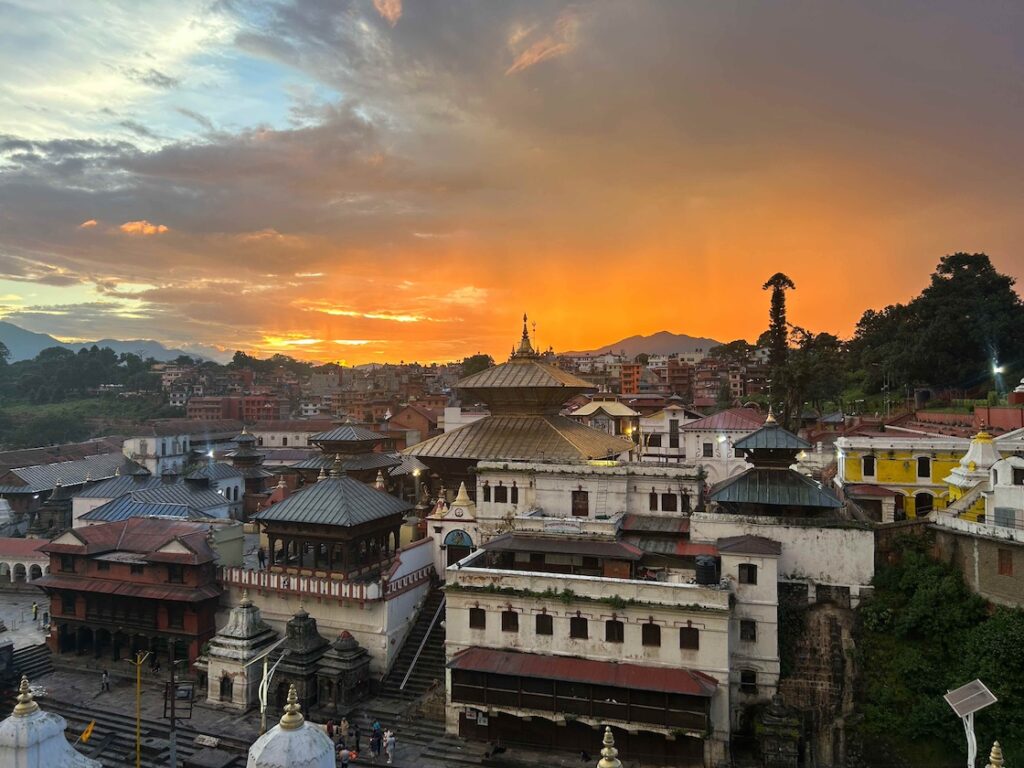
Beyond my initial first impressions of a developing country, I’ve come to see the resilience of the community beneath the surface. The Nepalis I’ve met work tirelessly to give their families a better life. Most greet me with warmth and a smile, even if their intentions might be to make a sale. They may not enjoy the comforts that are so common in the West – but many appear to cherish all they have.
14th September
I chose to join a group for this journey rather than trek alone—a decision based on practicality. Trekking solo is a different experience: you set your own pace, explore what catches your eye, and savour endless moments in solitude. But the risks of solo trekking—landslides, river crossings, injury, dehydration—are magnified here by the dangers of altitude sickness. In a place where the nearest hospital may be a hundred miles away, it’s hard to enjoy the journey fully. I like pushing my comfort zone, but having been defeated by the effects of altitude in the past, I’ve chosen to be sensible and join a likeminded group.
Meeting the team for the first time is the hardest part. Nerves spark thoughts of expectation and doubt that fade as quickly as they come. One by one, we gather in the hotel lobby, and a familiar chorus begins: ‘Where are you from?’ ‘What do you do?’ ‘Have you hiked much before?’ Over the next 14 days, we’ll be hiking, eating, drinking, sleeping, and sharing holes in the floor, so it’s best to get the basics out of the way now.
As our initial unease dissolves, it’s replaced by excitement, as learning about these folks will all be part of the adventure in the coming weeks. Our group is composed of men and women from twenty to forty, each with a different background. Some are seasoned Himalayan trekkers, while others have barely worn in their boots. It’s a rich and beautiful mix.
After introductions, our guides brief us on the ‘mission’ and treat us to a welcome dinner to break the first ice of the trip. In the morning, a convoy of buses and jeeps will carry us up to Tal (1,700 metres), at the edge of the Himalaya.
15th September
I rise in darkness to a rare peace and quiet in this city. We depart at the break of dawn to escape Kathmandu before the hive stirs. Our route to Tal stretches 112km on a patchwork of roads made from dirt, stone and tarmac. Buses, lorries and cars crawl from the city in a single file, kicking up so much dust I pull on a face mask just to breathe.
Roadsides are lined with homes and shops painted in shades of blue, pink, and red, built from materials gathered locally. Oak, alder, and maple trees form the frames, while stones and clay shape the walls. Lastly, corrugated iron roofs keep the monsoon rains at bay. These structures may be humble, but they stand resilient beside the single-track road leading to the capital.
The bus rattles beneath us like a bag of cutlery as it fords rivers, winds through gorges, and skirts the unsettling sights of landslides. People here are shaped by the ruggedness of their surroundings, which explains why Nepalis are revered for their resilience. Occasionally, locals emerge from the thicket, carrying wicker baskets on their backs, secured by a strap across their foreheads—a stark contrast to the UK, where the landscape has been tamed, and nature is confined to remote regions. Here, people rely on the Himalaya for survival rather than on supermarket aisles.
At midday, we switch from bus to jeep. From here, we leave the main road and start crawling up the Marsyangdi Valley. The Annapurna range dumps the last of the monsoon rains upon our jeep as we careen over mud and rock, all whilst our Nepali driver grins with glee. I chuckle along, filming the whole ordeal as we lurch from right to left, unaware of the impending doom that awaits us should our Mahindra 4×4 slide a few feet further to the right. I’m fortunate to be on the passenger side so I can’t see the hundred-foot drop that looms outside his door.
Fresh air drifts in through my window, but from the squeals in the back, it seems that the puddles aren’t the only thing splashing in. A few leeches have managed to navigate a crack in the window, hitching a ride with us at forty kilometres an hour.
We bounce along for three hours before finally reaching our first teahouse. My companions are stiff, sore, and—thanks to our wriggly friends—slightly drained, but we arrive in one piece. The rains continue to pour down from a sombre sky. It’s an appropriate welcome, a reminder of the Himalaya’s true nature; here, it’s not always blue skies and snow-capped peaks.
16th September
Beautiful trails like this attract kindred spirits. Day-to-day, we are nurses, lawyers, environmentalists, conservationists, engineers, scientists, builders, and marketers; yet here, a shared love of nature and a desire to explore the unknown binds us together.
Once more, we’re greeted by a steady downpour as we begin our trek to Bagarchap (2,100 meters). The paths mirror what we drove through yesterday; well-trodden with rock and gravel, punctuated by flooded sections. When the water rises to your shins, waterproofing becomes redundant, turning each step into a wet, squelching echo.

Today, water is both our companion and guide as we walk beside the Marsyangdi River. Around us, the subtropical biome stirs to life, with the first pines and rhododendrons reaching skyward. Most mammals and birds flee at the sound of our caravan of trekkers, leaving only the lively conversations of humans getting to know each other.
From our vantage point, blue and red iron roofs peek through the greenery below, where terraced villages are etched into the hillside, growing rice and millet. Above, thick clouds cap the valley, hiding the giants we know are watching. For now, the sensory feast—the terrain, flora, fauna, and unfamiliar faces—is already more than enough to digest. I wonder how long it will be before the Himalaya reveal their true form.
17th September
I’m reading Sylvain Tesson’s Consolations of the Forest before dawn and after dusk. For six months, he lived a solitary life in a Siberian cabin, with only books, vodka, cigars and the self for company. My curiosity flickers at this lifestyle – but it’s hard to define why.
This simplicity echoes in the Nepali communities here. Nearly everyone I meet embodies a quiet resilience, a grounded contentedness woven into their way of life. They face hardships with a grace I can only admire, showing a happiness that so many of us endlessly pursue.
Eighty-five percent of the population in these areas are self-sufficient. No supermarkets here, no nearby pharmacy—only what the land provides. If it can’t be sourced locally, it requires a journey by yak or the back of one strong Nepali. Over 20 million people in these mountainous regions grow the food they need to survive, relying on staples like rice, maize, millet, and vegetables. Families raise goats, yaks, and chickens for protein. Water flows freely from streams and waterfalls which they pipe directly into their homes. And when illness strikes, they make use of fruits, herbs, and roots found in the valleys.
At first glance, this lifestyle is precarious; both weather and disease have the potential to ravage these communities. Yet when I meet Nepalis, they welcome me with warm smiles and a glint in their eye – I sense a hint of shame having jumped to such dire conclusions.
They are a testament to humanity’s ability to adapt to the harshest of environments. I came here wrought with assumptions of danger lying behind every bend. Instead, they fizzle into the mountain air after meeting the people who call this their home. They are at peace with the realities of this place; both the delight it can bring and the desolation (as it did with the earthquake in 2015).
At mid-morning, we stop for tea in a small mountain hamlet, perched in an alpine valley with the river below. Marigolds brighten the windowsills, while cardamom pods dry atop iron roofs, infusing the air with a warm, peppery spice. Cardamom, ginger, cinnamon, cloves, nutmeg, and black pepper simmer together into Masala tea – which soon becomes the favoured drink of our group.
As the edge of the day’s heat begins to subside, we arrive in Chame. I settle into an enclosed nook on the balcony to absorb all I have sensed today. For the first time since stepping onto this sacred soil, a calmness rests upon me. Below my nest, men, women and children play badminton in the street. There’s the occasional crunch as straggling porters continue trudging along the path. Overlooking this scene, the clouds part to offer the first glimpse of Manaslu (8,163 metres).
I gaze back at the locals who continue their game, unimpressed by the appearance of one of the 14 highest mountains in the world, whose arrival here is as common as the sun setting.
18th September
Blue skies and skin-scorching sunshine grace this beautiful morning. The rains drifted away in the night, setting the stage for fourteen kilometres of trekking with over six hundred metres to climb. Every step is accompanied by the backing track of the Marsyangdi River which now winds to our left. The remnants of the jungle offer precious little shade, so we stop to rest along with Chyangra goats, whose wool will soon be spun into cashmere and sold in the alleyways of Kathmandu.
Cool air soon begins drying the sweat from our brows as the humid jungle evolves into a temperate forest. Ahead, the treeline integrates Blue Pines, Chir Pines, Himalayan Spruce and Fir. As we walk amongst them, the atmosphere settles. No longer do insects buzz past your ears, or leeches suck the life from your calves.
Another notable inhabitant of this biome is the apple tree. Thriving in this climate, the farmers turn its fruits into hot drinks, juices and pastries. My apple tea fizzles with a tart tang on the tongue, warming my stomach as I swallow. Elsewhere, the excitement crackles in our group with fresh pastries and espresso also available. It’s a sweet moment to savour, as such treats dwindle with every tea house we pass.
With the bittersweet taste of coffee and apple still lingering on our tastebuds, we reluctantly depart. I’ve decided to drop back thirty yards from the main group so my lungs and consciousness have space to breathe the dwindling mountain air. My heart is full after three days spent with my fellow trekkers, but now I feel a quiet shift within me, drawn toward the evolving reality of our surroundings.
Doing so allows the conscious to wander, with questions present in your life filling the void. There’s freedom to reflect on what led you here, and where to go next. I remind myself to be mindful; given too much air, these questions can stifle and even constrain. This is why reflecting in the Home of Snow is ideal; every thought dissolves with each new bird song, blooming flower and tree rustle on the trail.
Poking through the clouds as the sun sets to the west, are the ridges and rocks belonging to Annapurna II (7,937 metres) and Annapurna IV (7,525 metres). Eager for their true forms to be revealed, I settle on a rock to watch the evening unfold. The breeze is cool, but anticipation warms the fibres of my being.
As the sun lingers, the clouds part slowly, like a ship breaking through ice. Annapurna II’s jagged peak emerges. My senses fill with awe. It’s remarkable how much more detail the human eye can perceive when witnessed in person. Snow covers the summit like frosting on a cake, yet still, it retains a brutal edge. Sunlight sets the peak ablaze, sending wisps of vapour into the darkening sky as it melts the crust. Others look upon its face inspired to conquer its summit. But I am content to bask in its glory, sitting on my rock.
For two hours I am lost in its presence. Satisfaction snuggles me like a cosy coat. I forget how cool the air has become whilst the moon retreats. The clouds by now have faded into darkness, leaving the pure summits of Annapurna burning as white beacons against the night sky. Words are not sufficient to describe what my eyes have just witnessed.
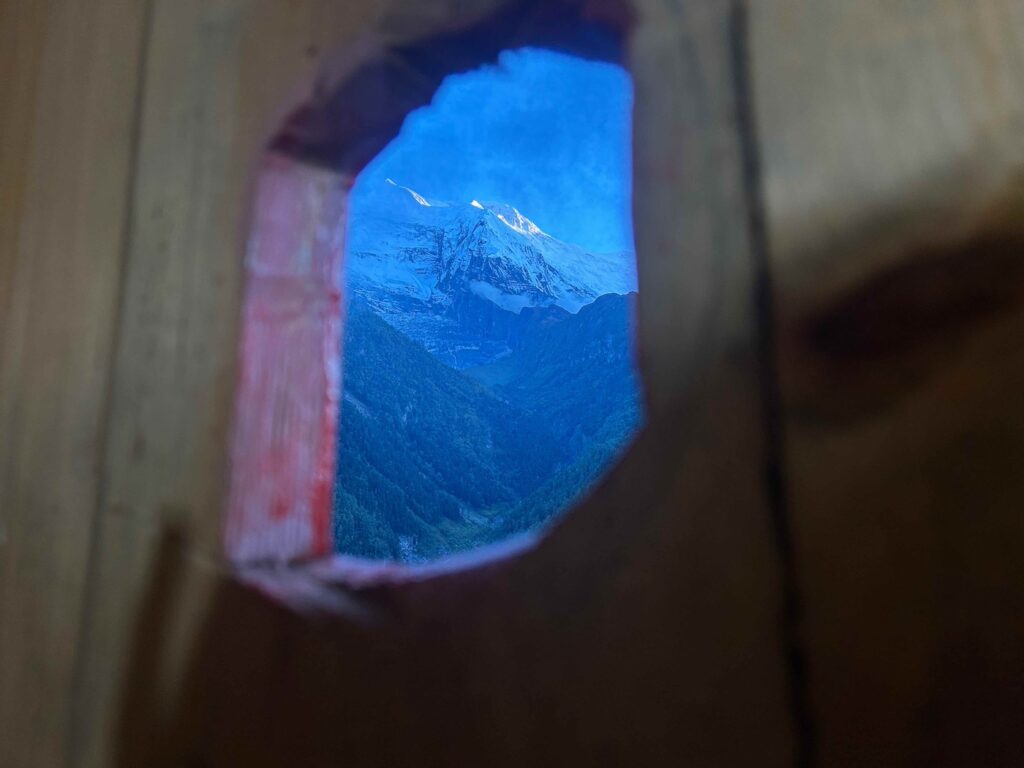
19th September
Dawn rises much like it set last night; full of hope. An infinite blue sky awaits, with the Annapurna range unveiled in its full glory. The route from here skirts around its ankles, whilst the forecast promises these conditions will persist until tomorrow; our timing could not be more immaculate.
Both Annapurna II and IV watch in silence whilst the anticipation hums in the stillness before our departure from Upper Pisang. For hours, I find myself glancing back, like a child lost in glee looking to be sure their parents are near. Each glance fills my stomach with a cocktail of relief and awe.
Walking this section is akin to strolling through an art gallery. Each bend we pass reveals another summit on display. I’d quite like to stay for hours and admire every stroke, colour and shade of this masterpiece. Annapurna III (7,555 metres), like its siblings, is an exquisite blend of whites, blues and greys. Intricate lines of snow and rock make every detail visible, even from miles away.
Soon after, Gangapurna (7,455 metres) comes into view, wearing a desolate calm that sends a shiver down one’s spine. Its name means “abundant in purity and life-giving essence”. A suitable name, given that from the summit, the eye is drawn to layers of white, then as your focus drifts lower, splashes of blue and grey emerge in the form of waterfalls erupting from its midriff.
Compared to when I researched this trip, I’m struck by how shallow pictures of these mountains are. An image gives you a visual sense of a subject; it’s pretty, but that is all. As you stand here in reality, how you perceive its matter is rich with detail. You hear the wind howling from its summit. You smell the earth and plant matter flourishing at its feet. You feel the brisk air nipping at your neckline. No picture can ever re-create such an experience.
For eight hours I walk in a trance-like state. I do not notice how the sun swells my skin and the UV saps the life from me because the Himalaya are nourishing my soul. Overhead, Himalayan Griffons, with wingspans of up to three metres, soar in silence. I imagine they are watching for the first straggler to succumb to the elements.
I am humbled by all I see, hear, smell, touch and even taste, but my brain is only capable of focusing on one matter at a time. It’s impossible to become lost in your past or future when in the presence of such an immense place. How insignificant your trials and tribulations become when experiencing earth in this way. I’ve often wondered what people who sit for hours admiring artwork in a gallery feel – I suspect it’s similar to what I’m experiencing here.
Like them, I study the myriad of sparkles glistening on the snow. I listen to every breath of breeze as it shifts and sways over the valley. I run my fingers over the rocks, the plants and the trees, noticing the tingle that ripples through my hands. I taste Dal Bhat, savouring the earthy and spicy tones that are synonymous with this area. I inhale the crisp mountain air as it inflates my lungs. In this place, in this moment, my heart is at peace.
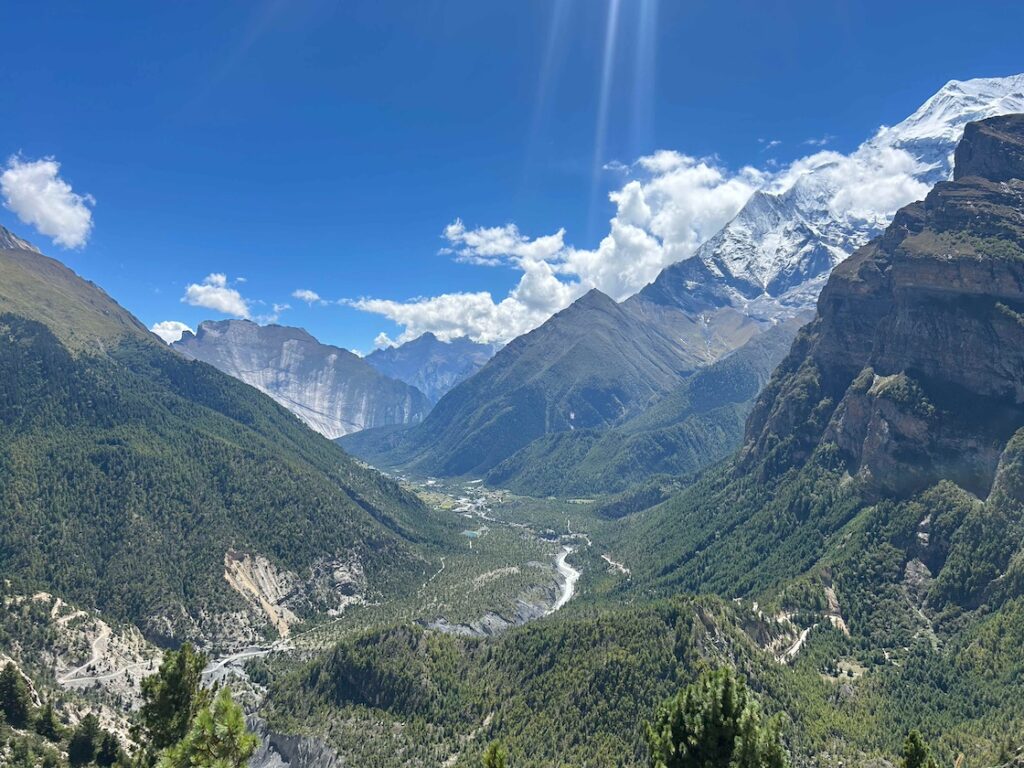
20th September
We arrived yesterday evening into the last significant town we will see for a week: Manang (3,540 metres). Three hundred souls settle here in the shadow of the mountain. Amongst their homes are tea houses, general stores, laundrettes and hiking shops. Our purpose for the next thirty-six hours is to acclimatise and gather vital supplies. Beyond this cheerful neighbourhood, snack options will dwindle, and the price of toilet roll doubles every night. Whilst wandering with our shopping lists, children dash through the streets shouting ‘Namas-te!’ in passing; we return their greetings with smiles and bows.
The effects of altitude are beginning to emerge above 3,000 metres. Each breath draws a fraction of the oxygen we’re used to. By Thorong La Pass, oxygen levels will be half those at sea level. As the composition of our blood changes, altitude sickness appears in the form of headaches, increased breathing rate, dizziness, nausea, loss of appetite and vomiting.
Complications with lungs I have come to expect, but issues with the digestive system are a surprise. With less oxygen pumping, our body is forced to adapt. It does this by prioritising oxygen where it’s needed most; our vital organs. However, it must do so at the expense of organs such as our digestive tract, which can be be placed into a ‘low-power mode’. It continues to function, but only by sacrificing its effectiveness. Heavy foods like meat and dairy put a considerable strain on this adaptation, as they require lots of this precious gas to extract nutrients we need.
By eating the local lasagne last night, I’m finding out what happens when you give the body this difficult dilemma. To process all that rich food, the body diverts more oxygen to my digestive system, and away from my vital organs, triggering brain fog, nausea and shortness of breath. If I am to make it to Thorong La Pass (5,416 metres), I will need to make my health the priority. While others in my crew will continue to risk the Yak steak and burger; I commit to eating the one thing I know I can stomach – Dal Bhat.
It has two main components; Dal (a lentil soup) and Bhat (boiled rice). Simple protein and carbohydrates, what more does a trekker need? It is often served with tarkari (vegetable curry), achar (pickle) and saag (leafy greens) based on availability and seasonality. Each is presented in bowls upon a large brass plate. Having watched the locals, the best way to enjoy is by combining the Dal and Bhat on the plate, then add nibbles of curry, pickle and greens with each mouthful.
Each time I order their signature dish, my guides welcome my choice with hearty applause, “Dal Bhat power, 24 hour!” they say, followed by a cheerful smirk. Whilst they joke, this simple dish provides the lifeblood necessary to thrive in the mountains. Everything assembled on this plate is grown locally and packed with easy-to-digest nutrition.
The rice and lentil soup has a subtle savoury flavour that warms the stomach on a chill evening. However, copious mouthfuls of this would soon get dull were it not for the accompaniments. The curry adds a distinct spice and saltiness which brings the lentil soup to life. You can then add a pickle for some acidic punch, or a mix of veggies to enhance the crunch of each mouthful. It’s basic in presentation, but the composition of Dal Bhat weaves together salt, fat, acid, heat and texture in delightful harmony.
Some find the prospect of eating the same dish twice a day monotonous or even nauseous, but I’m revelling in the subtle variety everywhere we stop. Each tea house has its own recipe that varies the ingredients, spices and even accompaniments. Every Dal Bhat is unique.
For example, some ingredients can only be grown in specific climates, making them available at one tea house, and then never again for the remainder of the trip. The added bonus is due to its role as a staple in the diet of the local people, you are offered second or even third servings. As such, I’m putting my faith in Dal Bhat’s legendary ‘24-hour power’ to get me over the pass—and keep my stomach in line along the way.
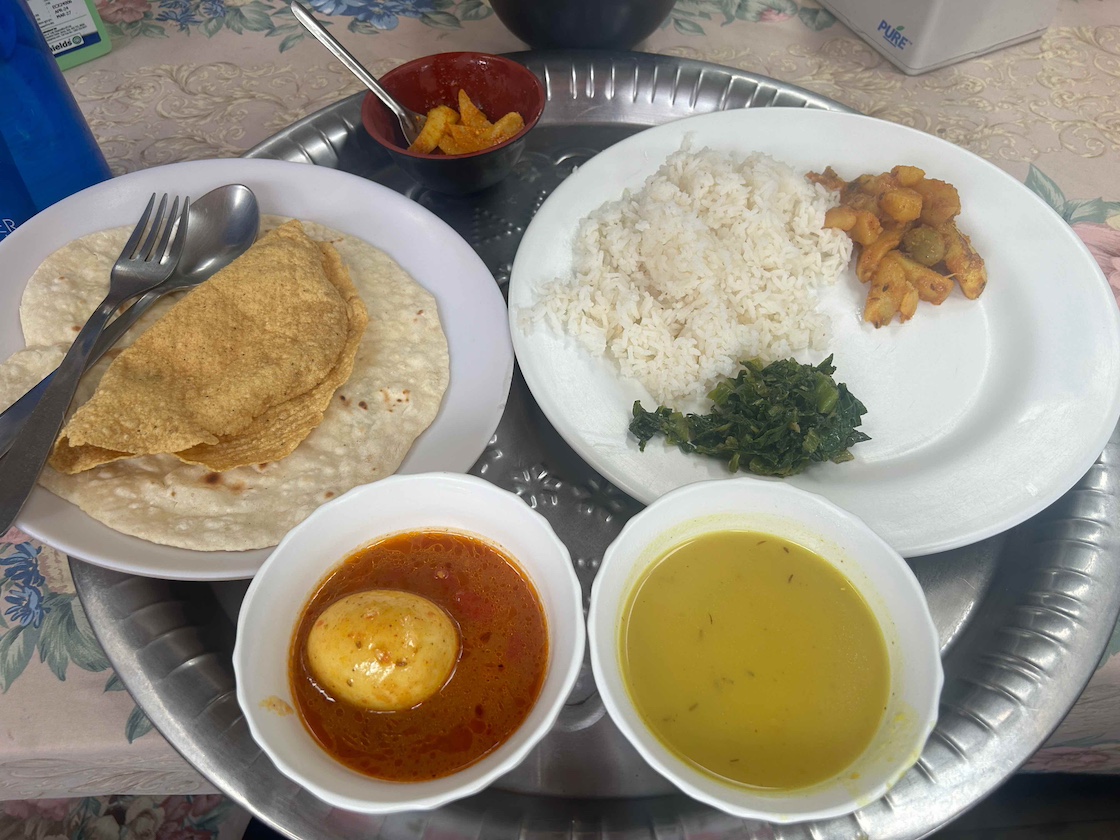
21st September
We return to the trail and continue onwards. By the end of today, we will push ourselves past the 4,000-metre barrier. It’s only six kilometres from here to Shree Kharka (4,073 metres), where we will arrive in time for lunch. Afterward, we will climb sharply by two-hundred metres, rest for thirty minutes, then descend back to our tea house for the night. This ritual is essential for adaptation, as the locals know well.
The significance of these small climbs is scarcely noticeable at first. On these short walks, our kidneys release hormones that trigger the production of more red blood cells, which have a greater capacity to carry oxygen, enabling us to do more with less. Meanwhile, haemoglobin—the protein responsible for transporting oxygen within those cells—also increases. Adaptation, however, is not completed overnight, so this will be our routine until we reach one of the world’s highest lakes: Tilicho.
Even on a flat trail departing Manang, I feel my breath quicken, and my heartbeat tremble. Starved of oxygen, it’s a welcome distraction for my mind to drift into a malaise of thought surrounding purpose. I arrived here with a clear sense of purpose, yet each day it shifts, changing shape into something more abstract.
Drifting deeper into introspection, I see how purpose is ever-evolving, yet here I am, my mind struggling to apply rational logic to it. All I feel certain of, in this setting, is a deep connection to nature and people.
As we walk in the shadows of Gangapurna and Annapurna III, I am moved both by the landscape, and the people I share these moments with. I find great energy in the mountains, as well as from the solitary souls who roam the world embracing all the goodness it has to offer. I’m fascinated by the competitors, who seek to conquer the obstacles that life presents. I admire the compassionate who wish nothing but the best for all of humanity. I believe we are each unique in where we find fulfilment in our lives.
As night closes in, clouds envelop our tea house that nestles on the shoulders of the valley. On the eastern flank, we overlook the river and forests below. Warm rays of sunshine comfort me as I sit on the roof, sensing all around me. As the sun sets, a biting cold snaps at bare skin. Inside, the atmosphere thrums as Nepalis, Brits, Israelis, Poles, Estonians and Americans huddle around tables with chess matches and card games in full swing. The waft of Dal Bhat, chow mein and egg-fried rice mingles with the stuffy air. I wonder to myself why they came here, what their purpose is, and whether they can even put it into words.
We must appreciate these moments – every moment – for they end as soon as they begin. The people, environment, atmosphere, temperature, ambience; all will never align again in such harmony.
22nd September
The Annapurna range lies hidden behind a thick white cloud, resting over the hillside like a soft blanket. A grey hue veils our trail, while a howling chill snaps at our skin as we advance to Tilicho Base Camp (4,150 metres).
It is an eerie morning. No longer do birds chirp at our departure from the teahouse. Even the wind relents as we step into a harsh and desolate landscape. The silence is deafening. Without the sun to warm us, the only colour bursts from vibrant layers keeping us warm. The bright, breezy days of the past week evaporate into memory as a bright blue sign greets us: ‘Danger: Landslide’.
Looking beyond its precarious message, the terrain is diagonal, with a precarious path cut through its centre. Silence swallows the air until each step on the landslide sheet sends echoes through the stillness. I concentrate on my stride, and the placement of every step. Glance to my left, and I am dizzied by a 100-foot drop. The gradient is so smooth, that were I to slip, I would not be able to prevent myself sliding into the graces of the valley below. Glance to my right, and tonnes of rock loom, threatening to shift and sweep me away.

For two kilometres, my only companions are the sound of my breath, my feet, and the occasional trickle of pebbles and stones shifting above. It’s a disquieting peace. I try to quell visions of how this place transforms when the first dominoes begin to fall. Upon hearing we must return via this route tomorrow afternoon, a shiver ripples along my spine.
As we approach base camp, exhaustion overtakes me. Either my body is revolting against my declining oxygen levels, or the intense concentration necessary to navigate the landslide fields has sapped all life from me. It is fortunate then, that another plate of Dal Bhat awaits to revive me before a short acclimatisation trek in the afternoon.
I savour these thirty minute breaks to detach from the group and meditate on the sights, sounds, smells and sensations that rise and fall in every moment. The meaning of peace is different here. Thoughts from an earlier conversation continue to bubble to the surface when I was asked: ‘Would you want to get married?’. My answer is not worth discussing here. What I find intriguing is that my answer has changed over the past decade. Five years ago, I was certain; now, I’m unsure.
I realise the reality that people are ever changing. How the world unfolds shapes our hopes, dreams, fears, doubts, and therefore our actions. The composition of our world evolves with each moment, and therefore, so do we. How can we say with certainty what we want, when our circumstances could change tomorrow? How can we rule out possibilities based on fears that exist in the mind alone?
Sat on this mountainside, watching the back of my eyelids, I see how my hopes and dreams have evolved related to a common major life decision. If change is possible there – what other parts of our self is liable to change? All of it? I came to these mountains seeking answers; instead, all I find are more questions.
23rd September
At four ‘o’ clock in the morning, base camp is the only place within forty kilometres of here teeming with movement. Grunts and groans greet the cool twilight air, spoons rattling as they plunge into bowls of porridge for strength. We’ll need it to climb over nine-hundred-metres before sunrise. The sounds of life evaporate soon after ascending into the night sky with only a head torch to guide us. It’s a personal delight to check back every one-hundred-metres to see the string of fairy lights swaying across the mountainside. If you have never had the joy of hiking in darkness, I’d recommend embracing the initial discomfort.
Our goal is one of the world’s highest lakes: Tilicho Lake (4,919 metres). The trail winds back and forth up another now familiar landslide field. Hundreds of hikers detour each day from the Annapurna Circuit to stand in its presence. This marks the second highest-point on our route, so I am welcoming the palpable tension that fills the darkness. A whisper within wonders whether altitude sickness will arise, only to escape into the ether soon after.
Every step has the sensation of striding through treacle. Each breath is a reminder of the thin air. Our caravan is slow, but moves with defiance. My breathing labours, but is never overwhelmed. I feel my heart vibrating in my rib cage as it squirms to cope. Only the use of a pacesetter to manage our exertions prevents me from cracking a rib.
The twilight hours fade into a dream. Each step dissipates into a familiar rhythm. It takes the emergence of the sun over my shoulder to startle me back to the present. Dawn rises to reveal a wall of snow wearing a circlet of clouds. The ground remains a blanket of grey; very little is capable of adapting to the harshness of life here.
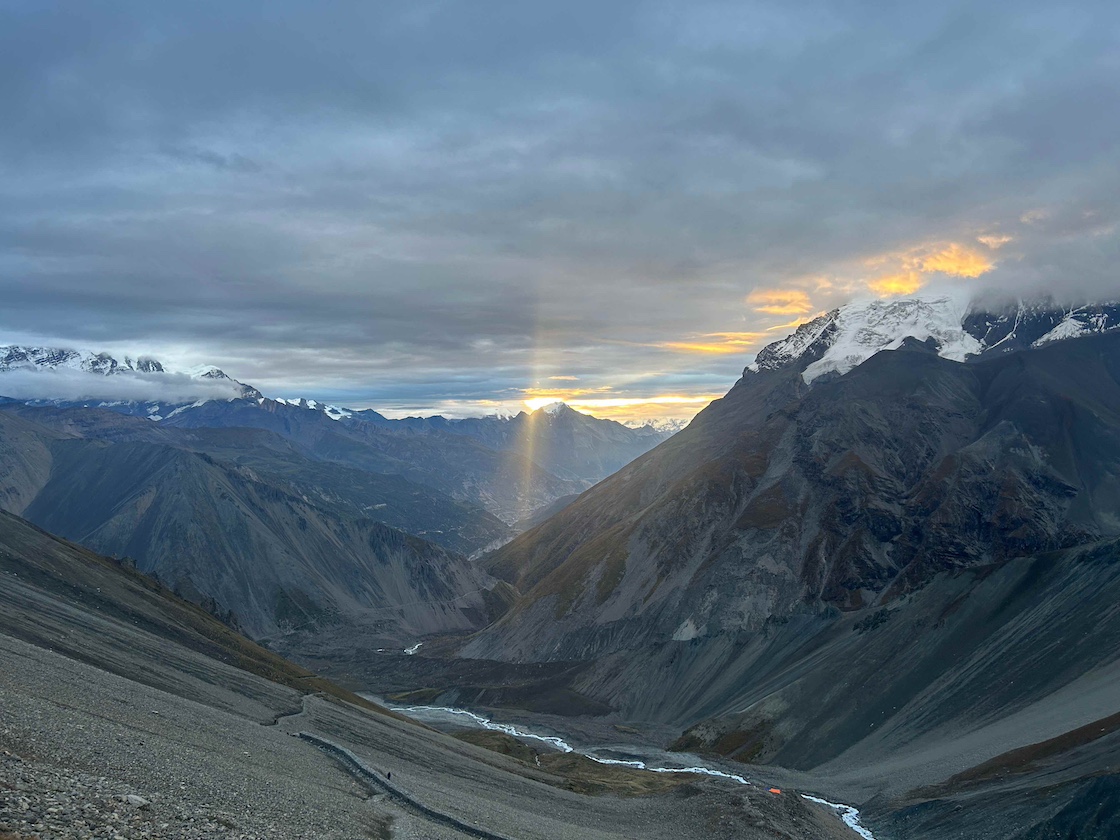
The monotone shades of the landscape are soon splashed with turquoise and cyan. After three hours of trudging through the bitter morning, we arrive. Surrounded by white mountains, the lake sits in silent stillness. It has the eerie quiet of a body laid to rest. There is no breeze, yet I feel the warmth of my blood abandoning me. Tilicho Peak (7,134 metres), the matter responsible for giving it form, watches our arrival from behind a curtain of cloud. It warns us of the perils of this place by rupturing the silence with a sharp CRACK as snow breaks free, crashing down the slope.
Tilicho Lake owes its existence to glacial melt. Over millennia, droplets have trickled down to fill this basin carved into the earth. The waters never venture far above freezing, ensuring very little can endure. No waterfowl call to each other along its shores. No fish dart below its surface. Even insects keep their distance. Only a handful of microorganisms have adapted to survive here, leaving no trace of their existence.

Savouring the accomplishment lingers for a few precious moments before being overcome by the glacial chill emanating from the lake. We must depart before the weather stirs and bewitches us here. Tilicho Peak bids us farewell, poking its face through the cloud as we begin turning our backs. With success in our hearts, we welcome the landslides with contented glee.
Any lingering doubts over my body’s ability to adapt now wash away. Memories of abandoning an attempt at the summit of Cerro Toco in February of 2023 flicker in my mind. They flee as soon as they begin, with the prospect of our greatest challenge coming into the view of my mind’s eye. If I can ascend over 800 metres to reach 4,919m with just a pinch of struggle, how much harder can it be to push to 5,416 metres?
I realise those thoughts are best left on the mountainside. It’s important to savour every drop of the present, for it will soon be lost forever. The sun will rise and fall many times before the final test arrives. Dwelling on it now sours the serene nature of this day. We have passed a trail that has claimed the lives of others without so much as the roll of a pebble. We have reached a glacial lake, where many have been beaten back by circumstance.
Savour all you have right now. Savour all you have achieved to get here. More challenges and obstacles will present themselves with time. But right now, in this moment, you are free.

24th September
Compared to Tilicho, the air at Shree Karkha (4,073 metres) feels rich with oxygen. Each breath is deep and satisfying, like gulping ladles of warm, hearty broth. After pushing our bodies to their limits, our twelve-kilometre walk to Yak Karkha (4,050 metres) feels like a gentle reprieve.
My steps feel light against the soil, and my mind is finally free to absorb the world around me again. It is not only me who is feeling rejuvenated at this altitude; the surrounding world has colour once again. We are on the fringes of the treeline here, enriching the air we breathe. The bravest of birds rejoice in this, fluttering through the canopies, and cheeping as we skip past.
Along the trail, juniper berries—known locally as blackberries—are abound. Thousands of these fragrant black beads line the trail, wafting a faint aroma across our path. In these parts, they have a potent purpose as part of medicines and rituals (they smell great if you burn them too).
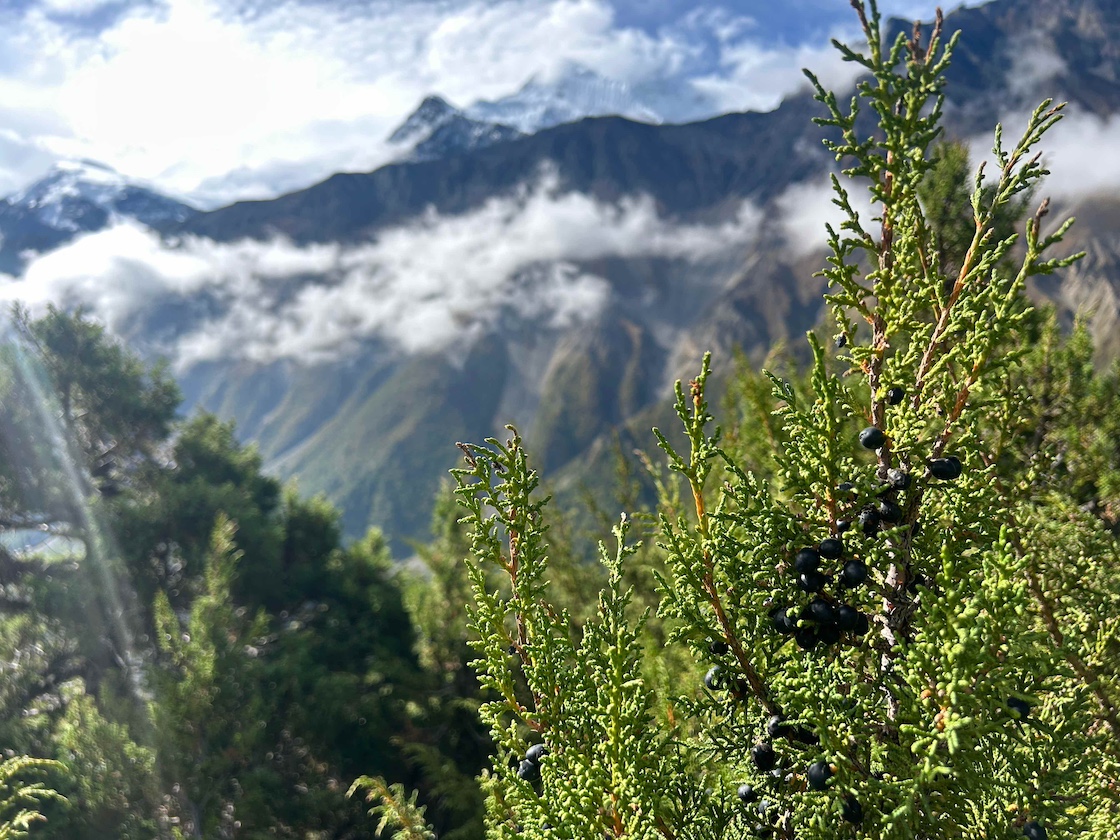
Look a little closer and speckles of vibrant orange also burst from neighbouring bushes. In the last two teahouses we have passed, my companions have been chugging a similar coloured beverage known only as ‘local juice’. These berries that look like droplets of sunshine are called ‘Sea Buckthorn’ – and they are the main ingredient in this juice. Rich in vitamin C and antioxidants, they are a versatile resource that reinforces the diets of local people here.
When picked from the plant, others squirm and spit them out for they are bitter in their raw form. However, combine them with other ingredients and they produce delicious juices, jams, pickles and more. They are also critical in medicines to treat Bronchitis, Asthma and throat pain. For a region notorious for its unforgiving nature, these resilient berries are a cheerful delight in a harsh place.
Our home for the night, Yak Kharka, takes its name from its most famous inhabitant. The Yaks, relatives of cattle, have adapted to thrive in this desolate environment . They share the muscular physique of a bull together with a thick coat that has seen better days. In addition, they walk on sturdy legs and heavy hooves that crunch in the frozen ground. Such adaptations mean they are unfazed by the subzero temperatures or the harsh terrain. As our band of merry hikers trickle into this chilly hamlet, hidden under the veil of the mountain, the yak watch with a gormless gaze.
I perch myself here for an evening of meditation, and to watch as they scale the steep inclines with the eloquence of a mountain goat on stilts. It’s clumsy, but effective. It’s from the female’s teet that cheese and milk are available in the tea houses. For the rest, they are the lifeblood of these communities; transporting food, gas, building materials and plenty more up and down the mountains. When these nomadic animals come across a doting cow, they produce hybrids; Dzos (males) and Chauris (females). Both are valued here for their milk, meat, and strength as pack animals.
Their grunts, groans and moos blend with the fading light as I bid a final farewell to Annapurna III and Gangapurna. By morning they will be smothered from view as we crawl up the valley. Our path now heads directly towards the pass of Thorong La and the Kali Gandaki.
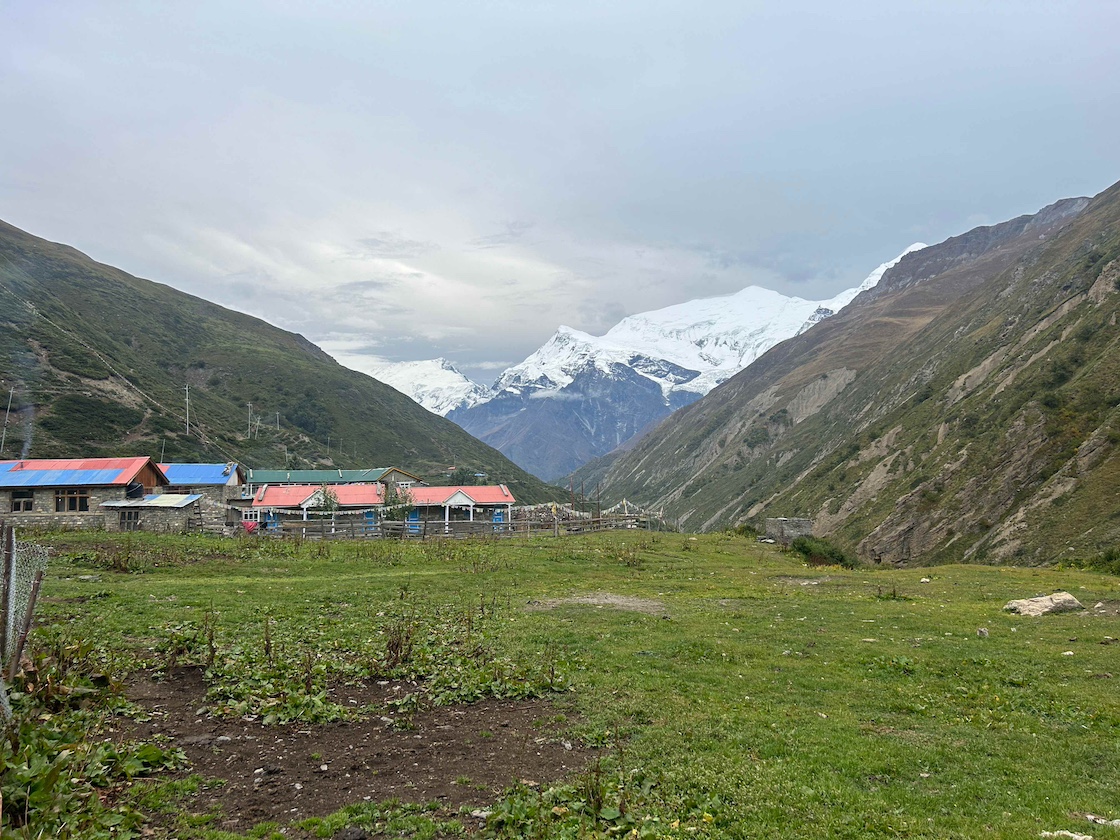
25th September
The jangling of a cowbell signals our departure this morning. We head to Thorong Phedi (4,540 metres) at the base of the pass. Our souls are nourished with the temporary return to vegetation, but as we climb once more, even grass fades in the frozen soil. Three hours is all it takes to cover the six kilometres on the schedule. The entirety of it is cloaked by thick white clouds that deny us a glimpse of the route onwards.
As the air thins, doubt and anticipation fill the void. Conversations in the group have been brief and sporadic. Thoughts shift to the challenge ahead. Somewhere, hidden by the rock and clouds, lies Thorong La Pass.
We are jolted back to the present by a final obstacle; the suspension bridge that looms beneath our teahouse. Sixty-metres long, it sways thirty-metres above the Jarsang Khola River. Knowing that yaks cross here regularly is a small comfort; my sixty-five-kilogram frame (plus seven kilos of gear) pales in comparison to theirs. I wait until the end to reduce the amount of swaying I have to endure. As I step on, my fingers tingle with the instinct to retreat. But the suspense is all for nothing, the swaying is minimal, and we reach the other side in a couple of minutes. I realise how you perceive matter is rarely consistent with your experience of it.
For now, we have the remainder of the day to acclimatise. At 4,540 metres, even a brisk walk steals your breath. The teahouse provides shelter and a warm meal, and as fellow wanderers retreat inside, we share our warmth and what little oxygen the room has. We breathe in shallow, recycled air, thinning it further with each exhale.
In search of peace and a few dregs of oxygen, I set off in the direction of the pass. I’ve spotted a perch one-hundred-metres above Thorong Phedi where I sit overlooking the river. Just as my breathing finds a familiar rhythm, my peace is startled by the sudden crack of stone falling from above. I’m startled to see Blue Sheep – Bharal – surfing down the sheer rock face. It turns out I’m sat in their lunch spot.
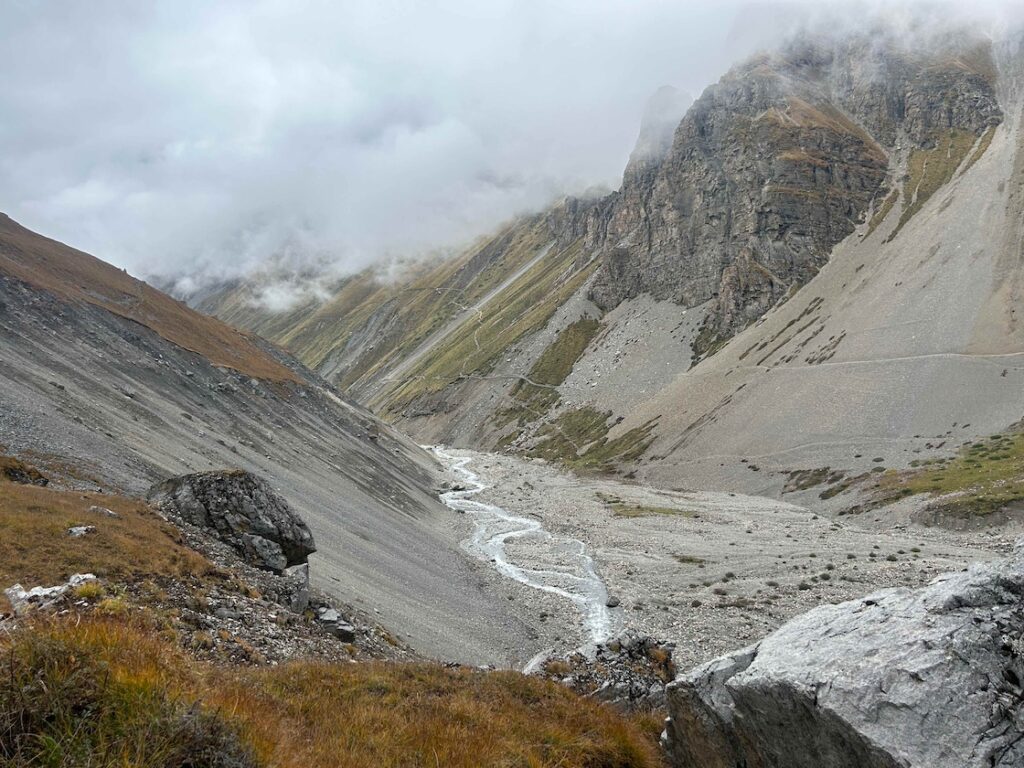
Blue Sheep are more closely related to goats than they are to their namesake. Their dense, blue-grey coats blend perfectly with the rock, and their large lungs and specialised hooves equip them for this stark landscape. They graze across Thorong Peak with the grace of a falling leaf.
Watching these creatures take this rough environment in their stride stirs something in me, and as they settle in for lunch, my thoughts drift back towards my own path. When trying to explain a career sabbatical to family, friends and now ex-colleagues, I reach for certainty—but it’s elusive. It’s not as simple as a break or just ‘travelling’; calling it that wouldn’t do it justice.
This is stepping into the unknown, guided only by a deep instinct. There is no predefined path, no destination, and no example to follow. It’s a personal journey that is by essence unique. How can one be taking a break, if they do not stand still? How can one be searching for purpose, when they are living it daily?
26th September
The teahouse’s floodlights pierce the mountainside, a silent beacon heralding the dawn of our great challenge. Beneath their harsh glow, we huddle together in our colourful jackets—splashes of vibrancy against the void of three o’clock in the morning. Steam rises from our breaths, mingling with unspoken anticipation as we gather the last of our supplies.
We begin with a gruelling ascent up to the saddle that lurked behind my perch yesterday. Headlamps and starlight illuminate our path, threading us through the darkness for two relentless hours. Below us, the trail flickers like strands of fairy lights, a luminous chain winding its way toward the clouds. Invigorated by shared purpose, we march with vigour to Thorong Base Camp (4,800 metres). Deep, long breaths punctuate the nervous calm that rests on this lonely outpost.
We are settling into the saddle as the sun rises on top of the world. With gradual inevitability, light lifts the veil on a haunting landscape. It reveals our trail cutting through the heart of the mountain, with peaks watching from each side. Despite the shadow they cast, the snow and rock appear as if in slow motion. As we pass the snowline of this range (5,000 metres), a familiar world fades, replaced by an unbroken sea of white. The surrounding amphitheatre reverberates the crunch of snow underfoot. In the crowd stand Thorong Peak, Khatung Kang (6,484 metres), and Annapurna III. We are in the presence of greater beings.
As the clock strikes seven ‘o’ clock, sunlight casts the clouds asunder. The Annapurna range is unveiled, paralysing our humble group with awe. For ten days, we have gazed upward from below the snowline, yearning for the high, frozen expanse. Now, the perspective is inverted. Immersed in the soft gradient of grey to white, I feel the transformation—darkness becomes light, and the world loses all meaning except this moment. I’m lost in wonder as a calm peace settles in every fibre of my being. I’m so dazzled I miss the passing of the 5,000-metre mark, and I succeed where I failed eighteen months ago.
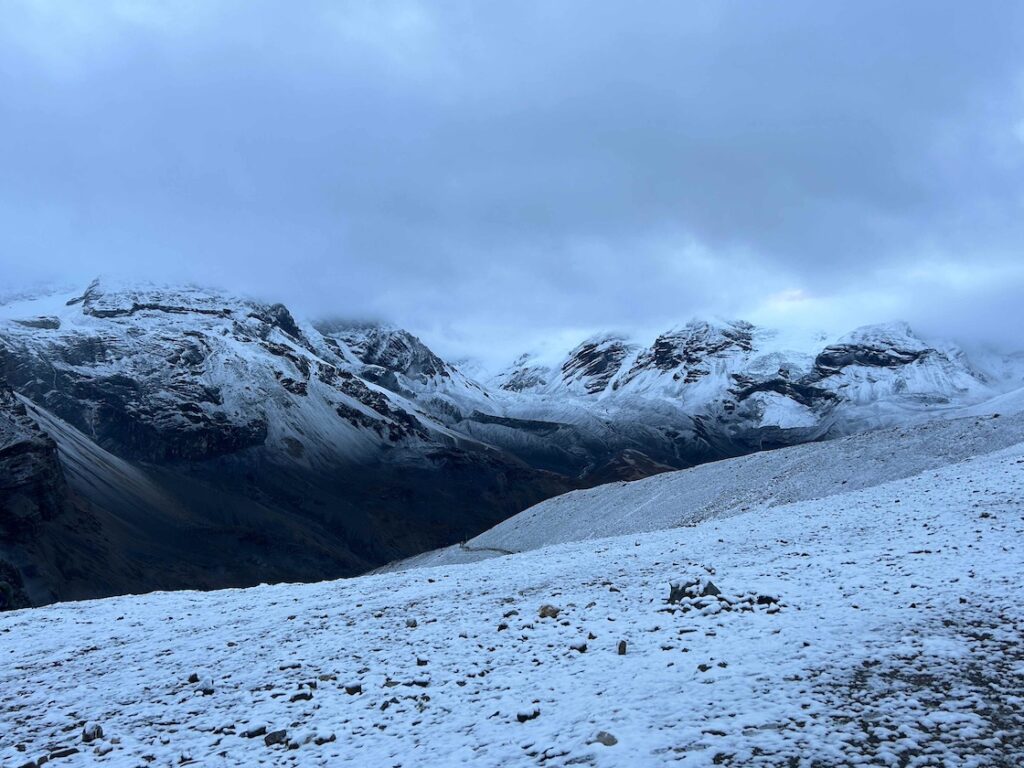
Snow blankets the world like a smooth, unbroken canvas, its purity broken only by our tracks. A sense of smell is absent, for all life has abandoned this place. We cannot dally for long, as we too will not survive here. Rays of light reflect off the snow, dazzling all who wander without sunglasses. The terrain shifts from the treacle-like effort of earlier days to the grating pull of slush underfoot. My breath grows heavier as clouds of vapour escape into the bitter air like a chimney. My heart rattles against my rib cage, sending vibrations reverberating up my spine. My consciousness is soon filled with a drumming THUMP, THUMP, THUMP, THUMP.
Through the banks of snow, we traipse higher, oblivious to how much further there is to go. Something else takes over in these moments. One falls into a trance, with concentration limited only to the next step, and another, and another. The task of climbing eight-hundred-metres in four hours is formidable at sea level; here, where air is wafer-thin, it is an eternity.
All I can sense through my trance is my breath drawing ever shorter, my heart thumping harder, nausea gurgling in my gut, and dizziness emerging even behind my sunglasses. Altitude sickness. Fear stirs in my heart, and all else but this moment disintegrates. There is no space to consider the past. No need to dream of the future. All that matters is moving each leg with purpose, keeping the breathing steady, and attempting to savour the moment.
My glazed eyes look up with hunger as flags appear on the horizon. On the blank white canvas I can see squares of blue, white, red, green and yellow. Each step towards them feels lighter, the tension in my body dissolving with every stride. These are Tibetan prayer flags; synonymous with ritual sites. They spread blessings to all beings, and as they come into view, a lightness appears. At 5,416 metres, Thorong La Pass arrives at last, and the curdling anxiety within retreats into thin air.
Together with my new friends, we share embraces, laughter, and relief—Thorong La welcomes us at eight ‘o’ clock in the morning of the 26th of September, 2024. The pass is majestic. It is as if one exists in a picture, for there is no wind, nor a single snowflake falling. A small stone hut offers hot tea, its fragrant steam curling into the frozen air. Our voices ring with exclamations and laughter, punctuated by a few errant snowballs. Through a break in the clouds, the Kali Gandaki Valley appears far below, a world away.
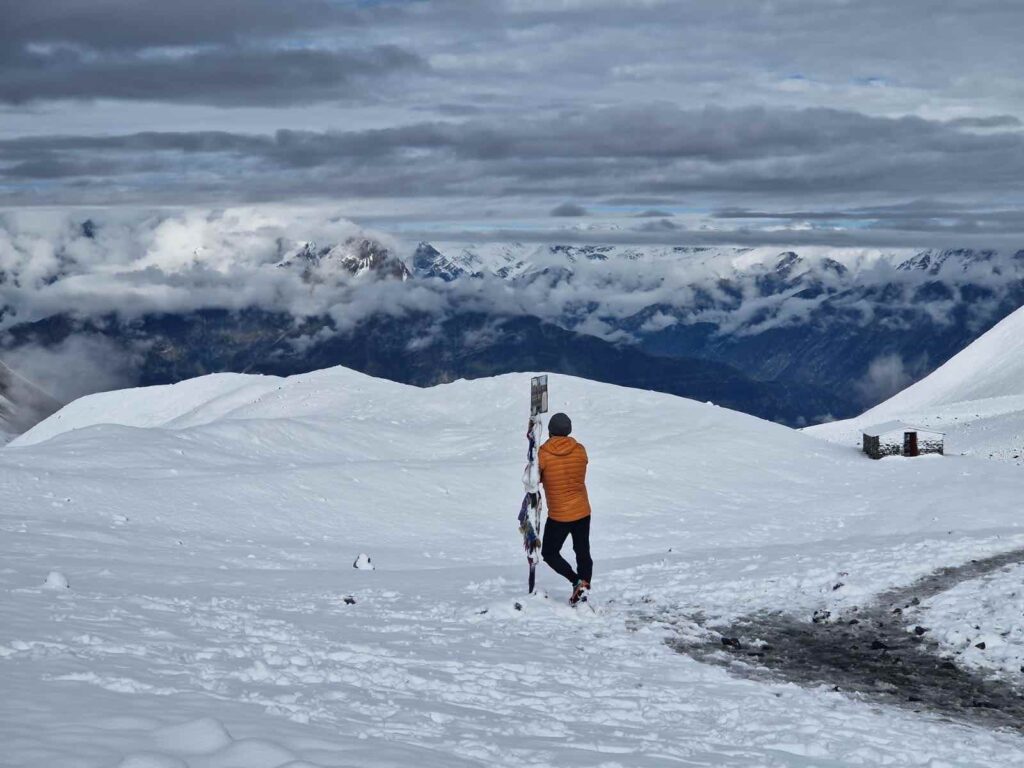
For thirty minutes, nothing else matters. For these rare moments, you leave behind your hopes, fears, loves, and regrets. The mountains hold us in their silent embrace, and peace fills the void left behind.
Only later do I learn this place claimed the lives of 43 people in 2014, when the weather turned treacherous. Locals believe the Gods protect those who cross safely. I cannot help but feel we have been watched over during these ten days.
It is a shame this peace will not last forever, but as in life, it is critical to keep moving forward. The descent from here takes us down over sixteen-hundred-metres in the space of 5 hours. The air thickens as we move at a fair pace, flooding my lungs with oxygen almost too rich to bear. My body reels as it is overwhelmed by the surge of life returning. The afternoon drifts past in a blur.
Blitzing past the snow line, the terrain turns to a pallet of grey and brown. Carrion crows circle overhead, searching for remnants of the day’s struggles. By evening, we reach Muktinath (3,800 metres), where lights glow from windows, voices murmur in nearby rooms, and the weight of the day fades. Words fail; all I can do is absorb it.
27th September
Rain pattering on the window pane stirs me from a deep stupor. It’s a familiar sound on our waterproof jackets and ponchos as we depart Muktinath for Jomsom. From there, the plan is to fly to Pokhara where we will return to a more complicated life.
Despite being only twenty kilometres apart, the ecology of Nepal’s Mustang region is in sharp contrast with that of Manang. To the east, we have become familiar with the lush green forests and grasslands consuming the landscape, while to the west, arid browns and greys now stretch across a terrain parched by the Annapurna range. Considering the world around us is so starved of moisture; it is unusual for rain to fall in growing abundance here.
Our legs, weary from Thorong La, trudge through the persistent downpour, each footstep sucking into the boggy ground. Any sense of triumph is swamped by the chill water dousing our bodies. Even with the blood rich in oxygen, all enthusiasm retreats as the dusty ground forms a thick sludge.
Cowering in our failing waterproofs, we beeline towards a small teahouse. Only my umpteenth serving of Dal Bhat gives me hope for the day ahead. Some do not experience such a revival. The executive decision is made to split our group into two for the final five or so kilometres. Half hire a bus, whilst the remainder will endure whatever the skies can muster this afternoon. Emboldened by the lentils and rice bubbling in my stomach, I join the latter.
Assuming your waterproofs hold, there is something quite stirring about walking in the rain. As droplets tumble from the skies, there is a rare solitude; life retreats, leaving only the valley’s quiet gasps as it soaks up the water it has been starved of.
Getting underway comes as a relief. Our guides lead us off the dreary tarmacked road and down to the riverbed where rainwater hurtles downstream. The waters have a thick brown appearance, almost like chocolate milk. I ask our guides whether this is normal, but their response is muted. Instead, they draw attention to ancient fossils loosened by the rain, and wash down the mountain. My doubts linger, yet there is no choice but to press on.
Even as the rains do not relent, one savours the last steps. With the riverbed swelling, Jomsom comes into view. The end of our trek arrives, and a bittersweet salve touches the tongue.
I strip off my defiant waterproofs whilst my compatriots applaud our arrival. We have completed our mission, yet it does not feel like victory. Relief is absent; I am already missing all we have experienced.
A solemn mood settles upon me for the afternoon. To distract from my melancholy, I am reading the final pages of Herman Hesse’s Siddhartha. Sometimes profound insight has a way of finding you when it is ready. Today it finds me in the final pages of this book, on the final day walking, during the final evening as a group. Below I paraphrase the insight in my journal:
‘You can either live a life of searching or one of finding. If you spend your life searching, you give all your attention to answering questions there is no answer to. If you spend your life finding, you find joy in the present, and in the world around you.
‘If you chase a life of happiness and fulfilment, will you ever be happy and fulfilled? Or will you always be chasing?
‘Fulfilment does not stem from the achievement of milestones and goals. Fulfilment can be seeing the sunrise, feeling the warmth of a loved one’s embrace, hearing a bird’s song, tasting sweet honey, or smelling the first blooms of spring.
‘I came here intent on understanding the purposeful direction of my life. But in searching, I have lost my way. In the search of a meaningful future, I have abandoned all that matters in the world around me.’
Our final night together with our guides and porters is spent sharing food, stories and dances; unaware of all that unfolds outside our windows. Unbeknownst to us, the rain has not ceased since we arrived, and the chattering of the droplets on the window grows heavier as darkness falls. They are drowned out by the Nepali pop music that blares from the speaker. For one night, we are equal and we are one. Ignorant bliss.
28th September
The five o’clock alarm jars us awake, joined by the now-familiar drumming of rain against the window. Our early start is a last-ditch attempt to flee the storm, and we gather in the dining room, bleary-eyed, hoping for a way forward.
The news is bleak, and confirms our suspicions. Heavy rain in Mustang means extraordinary rainfall elsewhere in the Kathmandu region. Between nine and twelve inches (228mm – 305mm) have fallen in some areas. We are once again fortunate, as the Annapurna range shielded us from much of its wrath. At the moment, it is hard to appreciate how fortunate we are. Trekkers who are a day behind us report that Thorong Phedi, once green and grey, is now swallowed by thick white snow.
As the day unfolds, the death toll climbs. Fifty-six, ninety-four… by nightfall, it will exceed two hundred, with many still missing. The Kathmandu Post declares this the worst storm in over fifty years. With the difference of a single day, and this story might have ended very differently.
Flights are grounded and buses are cancelled. Owners of 4×4 Mahindra’s relish these conditions, as they are the only mode of transport suitable. Local police report four landslides have already consumed sections of the road we must drive through. Those haunting landslides that we tip-toed through a week ago? I shudder at the thought of what has happened there overnight. The weather has an unpredictable nature in the mountains, but it’s rare for it to have such a devastating effect.
The decision is made to proceed and remain positive. The drive is four and a half hours as the crow flies, but with roads crumbling into rivers, it is unknown how the day will unfold. Our driver approaches the route like it’s just another day on the job, steering single-handed with a half-smile on his satisfied face. Only when we careen over rocks and edge closer to the cliff’s edge does he deem the other hand necessary. His calmness is bizarre, yet he personifies the Nepali belief in accepting suffering as a fact of life. So I settle into my seat, and allow the present to unfold as it wills.
Our driver is content to peer through a hole in a steamed up windscreen for the first five miles, so I wind the window down to release the tension from within. For three hours, I gaze out the passenger window at what strikes me as the beginning of a disaster movie. Inside the jeep, we sit in suspense, every lurch and skid bringing a collective intake of breath. Outside, swollen rivers churn with reckless abandon, their thick brown waters spewing over banks, ripping through tree roots and soil alike.
We manage to cover three-quarters of our route before we reach a tailback of vehicles. Landslide. It takes five minutes to walk past the train of jeeps and brave buses to see the obstruction. Five metres of the road has vanished, absorbed by the river that thunders past on our left. Already the locals have commandeered a digger and are rebuilding it with stone and topsoil pulled from the hillside without so much as a second thought. Fellow Nepali drivers huddle around to shout what I imagine are instructions on how a road should be built. Within thirty minutes, the road is clear. Given the turnaround time on building a road in these parts, I’m unsure whether to be impressed or concerned.
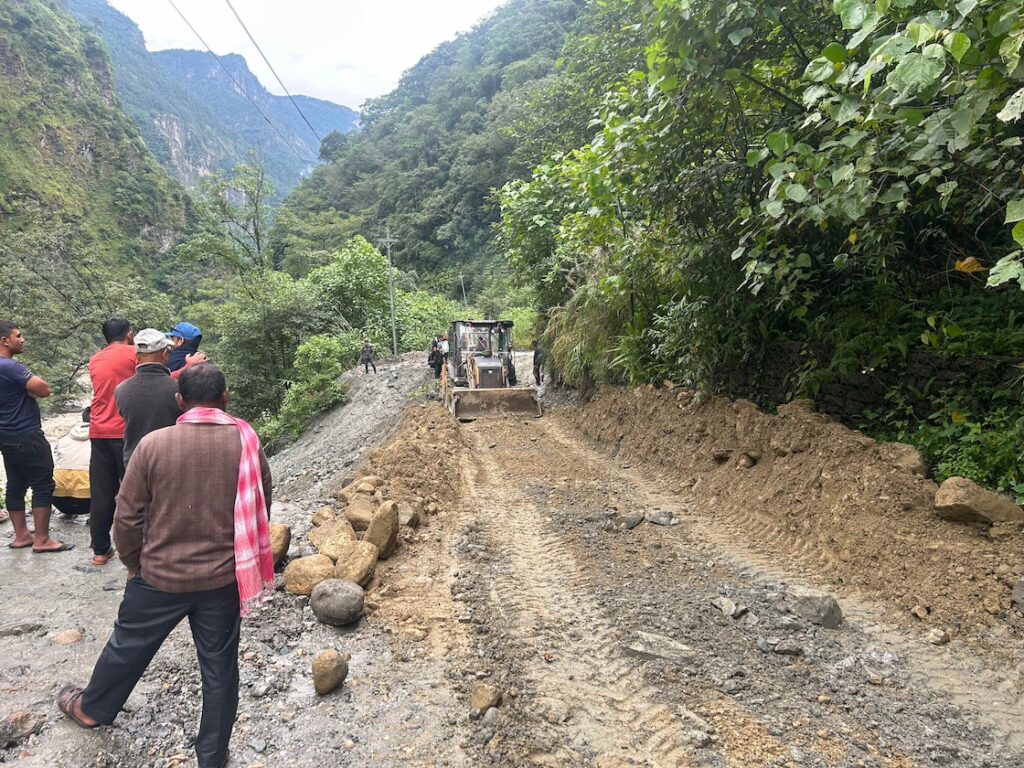
The journey, anticipated to take eight hours, concludes in under five. Pokhara greets us with warm sun, an almost surreal end to the day’s turmoil. Behind us, however, our porters have encountered four landslides. It chills me to think of the fragile roads, crumbling away as we drive over them.
I find it hard to appreciate the peril of our situation, given we appear to have glanced its blow multiple times. What if the rains fell whilst we were climbing to the pass? What if we were caught as the ground disintegrated on the road back to Pokhara? What if we got stuck on that road, with no way forward, and no way back?
Fortune looks upon us…
29th September
In Pokhara, the sun serves as a balm for our frayed nerves, casting a gentle light over Phewa Lake. Gondola boats glide serenely across its surface, an almost surreal sight compared to the storm-battered landscapes we’ve left behind. The city seems to exist in a bubble of calm, far removed from the chaos unfolding elsewhere. As I stroll along the lake, tourists laugh, sipping smoothies, while the locals greet me with their signature half-smiles and a cheerful ‘Namas-te!’ I wonder if this is all just a dream, as no one here seems aware of the devastation continuing to unravel.
Yet this story feels incomplete, unfinished, while flooding continues to consume the Kathmandu Valley. My companions scatter, each one setting off in their own direction. Some board flights home, others venture onward, and a few continue to savour the tranquillity of this bubble.
My well-laid plan had been to visit Chitwan National Park in hopes of encountering elephants, tigers, and rhinoceros. But now, in this moment, that journey feels too treacherous, a reminder that fortune, like the weather, is unpredictable. As Pokhara stands as an unexpected oasis amidst the storms, I, too, decide to savour the strange gift of this moment, appreciating its serenity while it lasts.
I’m not one to believe in the cliché that ‘things happen for a reason.’ And yet, is it not ironic, even poetic, that my carefully laid plans have been upended by circumstance? Torn from the path I envisioned, I find myself in a place I had never heard of just two weeks ago—a place of quiet beauty and unexpected peace. Perhaps it is here, in the surrender to the unplanned, that I’ve found a deeper sense of purpose.
Beauty exists in every moment, if only we open ourselves to it.